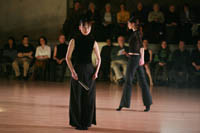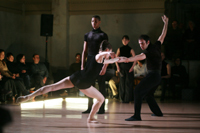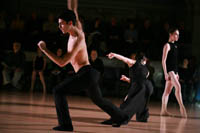
Jack Anderson
Xenakis at Judson
"Xenakis and Japan"
Electronic Music Foundation
Judson Memorial Church, 55 Washington Square South, Greenwich Village
February 28, 2010
Information: www.emfproductions.org
Reviewed by Jack Anderson, March 2, 2010
 |
"Xenakis and Japan" made it seem like 1967 all over again at Judson Memorial Church. Or 1966. Or 1968. Or any of those years when the church was regularly the site of unusual dance performances that attracted eager audiences. For this presentation by EMF (the Electronic Music Foundation), the church was crowded with dancegoers seated on all four sides of the space, with other viewers stationed in the balcony. A buzz of conversation could be heard along with the buzzing electronic sounds of "Concret PH," the piece that served as an overture to this musical and choreographic tribute to Iannis Xenakis (1922-2001), an experimental composer of ferociously complex scores for both conventional instruments and electronic devices.
Luca Veggetti, who choreographed, directed, and designed the production, has said he wished to celebrate the profound influence of Japanese art upon Xenakis, and among his performers was Ryoko Aoki, one of the few women in Japan associated with the traditionally male and often elaborate Noh theater. But she and everyone else in the cast wore austere costumes and Veggetti made no attempt to luxuriate in exotic local color. Rather, his choreography as a whole suggested the formality of some Japanese art styles, and his dance phrases brought to mind the clear, yet intricate, lines of Japanese calligraphy.
 |
The boundaries of the performance area were marked off on the floor by tubes of bright fluorescent light. As a result, the evening got off to a potentially catastrophic start when a passerby accidentally bumped into a tube and smashed it, sending bits of shattered glass scattering everywhere, to the evident horror of dancers Veggetti had seated amongst the audience. But the debris was soon vacuumed away and "Orient-Occident," the first piece, proceeded without trouble.
 |
Its electronic sounds filled the space like waves of cosmic energy. Dancers from the Purchase Dance Corps of the Conservatory of Dance at Purchase College rose from their places in the audience and moved to the center of the space, often with sliding steps. And Veggetti emphasized slides throughout the evening.
Xenakis called some of his scores sonic galaxies. I don't know how he would classify this one, but its burstings did suggest the formation of constellations. So did the dancers as they clotted and dispersed, spinning off like fragments of a newly created universe. The musical phrases seemed to push the dancers along, while the dancers' movements served as kinetic counterparts to the music.
Robert Black was the double bassist in "Theraps," a solo that sent Frances Chiaverini twisting, often with a vigor that was interrupted by sudden pauses. Again, the music appeared to drive the dancer onward, and the dancer created the illusion of being an inseparable part of the music.
 |
In "Hibiki-Hana-Ma," an electronic piece, Ryoko Aoki posed solemnly, a still point in a churning universe magnetizing members of the Purchase Dance Corps to gather around her, forming choreographic crystals that soon broke apart, often with Veggetti's characteristic slidings. Aoki began to move, taking tiny steps, raising a hand with an unopened fan, as if she were an orchestral conductor with a baton. Later, she opened the fan and walked forward until the taped music suddenly stopped. So did she. And so did the dance.
James Nyoraku Schlefer entered with a shakuhachi flute on which he played Yuji Takahashi's "Shigure." No one stirred. The creation of this musical and choreographic universe had reached a day of rest, allowing one to mull over the intelligent production, contemplate Judson's architecture, and hope to see more productions soon in this now-legendary space.
| museums | NYTW mail | recordings | coupons | publications | classified |
